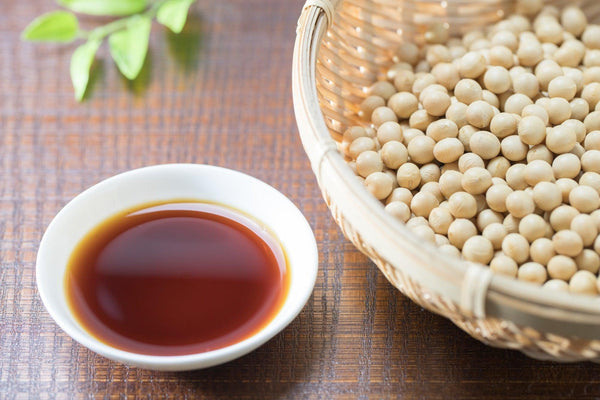
Jump to:
Although there are many types of Shoyu, or Japanese soy sauce on the market (in this post, we will use the term Shoyu to distinguish it from Chinese soy sauce and other varieties), the two main players are undoubtedly Koikuchi Shoyu and Usukuchi Shoyu. These words translate literally as “dark” and “light”, and as the word “light” in English culinary parlance has the connotation of being healthy, in terms of low in salt or fat, this sometimes leads to a misconception among non-Japanese people that “light” refers to its taste or composition. “Light”, however, certainly does not mean less flavorful, and merely refers to its color.
In this blog post, we will look at the characteristics of Usukuchi Shoyu, compare it with Koikuchi Shoyu, examine its history, differences in its production process compared to other types of Shoyu, reasons for its popularity in the Kansai region, and how it is used in cooking. We will also introduce you to some popular brands of Usukuchi Shoyu that you might like to try.
What Is Usukuchi Shoyu?

Usukuchi Shoyu is the second most popular type of Shoyu in Japan with an approximate 8% share of the market (for more information on different types of Shoyu and a generally great introduction to the topic, check out this post.)
It is light in terms of color and body, has a fruity aroma, a slightly sweet yet refreshingly tart flavor, and a subtle form of umami. This makes it an ideal seasoning and sauce for lightly flavored dishes and snacks, as well as fresh foods.
Deceptively, despite its light color, it has a higher salt content, at 18-19% than its darker Koikuchi Shoyu counterpart (see here, for more information on Koikuchi Shoyu). Whereas Koikuchi Shoyu has a stronger aroma, which is often used to mask the smell of foods with a stronger odor, such as blue fish and meat, Usukuchi Shoyu, born in the Kansai region, is often used in Kyoto cuisine, where the color, flavor, and aroma of the ingredients need to be brought out.
As previously stated, color is an important aspect of Usukuchi Shoyu and as its color will become darker the more it oxidizes, this will cause it to lose its characteristic lightness. For this reason, the shelf life (before opening) of Usukuchi Shoyu sauce is often set about 6 months shorter than that of Koikuchi Shoyu, and it should be consumed within approximately one month of being opened.
Origins Of Usukuchi Shoyu?

The process of creating Usukuchi Shoyu is said to have been developed in Tatsuno in the southwest of Hyogo Prefecture around 1666. This area ticked all the boxes for a prime Shoyu production area, with ready access to soybeans and wheat and a good source of water, in the Ibo River, important for both the flavor of the Shoyu produced and transportation of the finished article to other areas.
It was found, however, that the softness of the water in the river caused the Shoyu to go rancid quickly. Amazake (a fermented rice drink, which we also have an article about) was added to help prevent this and, in one of those fortuitous accidents, was found to give the Shoyu a lighter color and a pleasant sweetness. The method of manufacture was developed further, through a process of trial and error, and its refined taste became the basis for the vegetarian temple cuisine of Shojin Ryori, traditional home cooking, and Kaiseki Ryori in the Kansai area.
How Is Usukuchi Shoyu Made?
The process for making Usukuchi Shoyu is similar to that of Koikuchi Shoyu, in that soybeans and wheat are combined with koji mold (which acts as a fermenting agent) in tanks with brine water, and this is used to make an unfermented solution called moromi. However, in the case of Usukuchi Shoyu, rice and Amazake are often added to provide a more mellow taste and aroma. The fermentation and aging processes are made more gradual by the higher salt content of Usukuchi Shoyu, the temperature is also lowered during these processes, and the brewing time is shortened to produce a lighter color.
Usukuchi Shoyu – The Regional Bias

Despite being the second most popular type of Shoyu in Japan, Usukuchi Shoyu is often conspicuous by its absence from the kitchens of Kanto households. In fact, the only time many people come into contact with it may be when visiting a Kyoto-style Ryotei restaurant. So why is there such a strong Kansai bias in the consumption of Usukuchi Shoyu?
In Kansai cuisine, there has long been an emphasis on the dashi, or broth, used in a dish, the taste of which is accentuated by the soft water found in the region. In fact, Kansai chefs have long bemoaned that even if they use the same ingredients, they cannot recreate the same taste when they make the broth in Kanto.
Around the time Shoyu was first being developed, Kansai consumers had access to succulent vegetables and delicately flavored white fish, compared to their Kanto counterparts who were dining on poorer quality plants and blue fish with a pungent aroma. Whereas, therefore, the focus of the Koikuchi Shoyu developed in Kanto was a soy sauce that provided a dominant taste and aroma that masked inadequacies and strong odors in the base ingredients, Usukuchi Shoyu looked to enhance the flavor of natural ingredients and the dashi.
Presentation is also important in Kansai cuisine and the light, amber color of Usukuchi Shoyu makes it a perfect fit for the Kyo and Kaiseki Cuisine of the Kansai region.
As we can see, therefore, there are environmental, historical, and cultural forces at play that have shaped the current trends in Shoyu consumption in Japan.
How Is Usukuchi Used In Cooking?

As mentioned above, the emphasis when using Usukuchi Shoyu is dishes that have a delicacy and subtlety in taste and/or color. It is used in dishes, therefore, such as Kansai-style oden, Dashimaki-Tamago (rolled egg), chawanmushi (steamed egg custard), and Osuimono (clear soup) where the aim is to create dishes packed with umami, but which retain the original color of the ingredients.
One thing to be aware of when cooking with Usukuchi Shoyu is that it has approximately 10% more salt than Koikuchi Shoyu, so it is safer to add just a little at a time and taste it regularly. It can be difficult to estimate the correct amount to add, but a useful reference point is that a tablespoon of Usukuchi Shoyu contains just over half a teaspoon of salt.
Unlike its darker counterpart, Usukuchi Shoyu is not generally used as a dipping sauce because of its saltiness (although read on to our brand section for some notable exceptions). It tends to go well with white-fleshed seafood, chicken, lean pork, eggs, tofu, and all varieties of vegetables.
Where To Get Usukuchi Shoyu?

You can find Usukuchi Shoyu in most supermarkets and many grocery stores, but another great place to start is the Japanese Taste website where you can order several different varieties of Usukuchi Shoyu online. In this section, we'll cover some of the main and best Usukuchi brands and products made in Japan.
As described earlier in this post, Tatsuno in Hyogo Prefecture is the birthplace of Usukuchi Shoyu and Suehiro is a company, founded in 1879, whose mission is to bring its customers a high-quality product that continues the traditions of Shoyu production from Tatsuno, where it is located.
Whereas some of Suehiro’s offerings only use the three ingredients of wheat, soybeans, and salt, its Tatsuno Usumurasaki is an example of a product in which the traditional method of using rice malt in Tatsuno is used to produce a mild sweet taste that in addition to giving simmered foods a mellower taste, also makes it suitable as both a pouring and dipping Shoyu.
Teraoka is a Shoyu brewery based in Hiroshima that prides itself on delivering Shoyu of the highest quality containing completely organic ingredients. In recognition of its efforts in this regard, it was awarded organic JAS accreditation by JONA (Japan Organic & Natural Foods Organization) in 2001.
Teraoka has produced this organic Usukuchi Shoyu, brimming with umami and containing only organically-produced non-GMO soybeans, wheat, and salt that you can use in your cooking to accentuate the existing color and taste of the base ingredients.
Daitoku is another welcome addition to the Japanese Taste website. Unlike the vast majority (approximately 97%) of Shoyu produced in Japan, 100% of the Shoyu from Daitoku is produced using only domestic non-GMO ingredients and brewed and aged naturally, without the use of chemicals or synthetic preservatives.
Daitoku is a firm believer in the necessity of good ingredients to make top quality Shoyu, and they are even particular about the source of the salt, using only Hirakama salt from the Sakaido Island off of Nagasaki, which has been found to have a good balance of minerals for a more mellow flavor.
Their delicious Usukuchi Shoyu can be used in a wide range of dishes but is particularly suited for drawing out the natural flavors of fresh vegetables fish and meat.
Usukuchi Shoyu – More Than Just Kansai Shoyu

As discussed, there is a strong regional bias in Shoyu use in Japan with historical, environmental, and cultural factors playing a role in molding the propensity for the heavy use of Usukuchi Shoyu in the Kansai region and cuisine.
Although consumption of Usukuchi Shoyu outside the west of Japan is low, even among Japanese consumers, its mellow, fruity aroma, its tart sweetness, and delicate umami mean that it has plenty to offer the more adventurous culinary aficionado, regardless of where you are located. Why not grab a bottle and explore what its subtle flavor can do for your cooking?
Have you found a good way of incorporating Usukuchi Shoyu in your cooking? Please share it with us in the comments.


0 comments